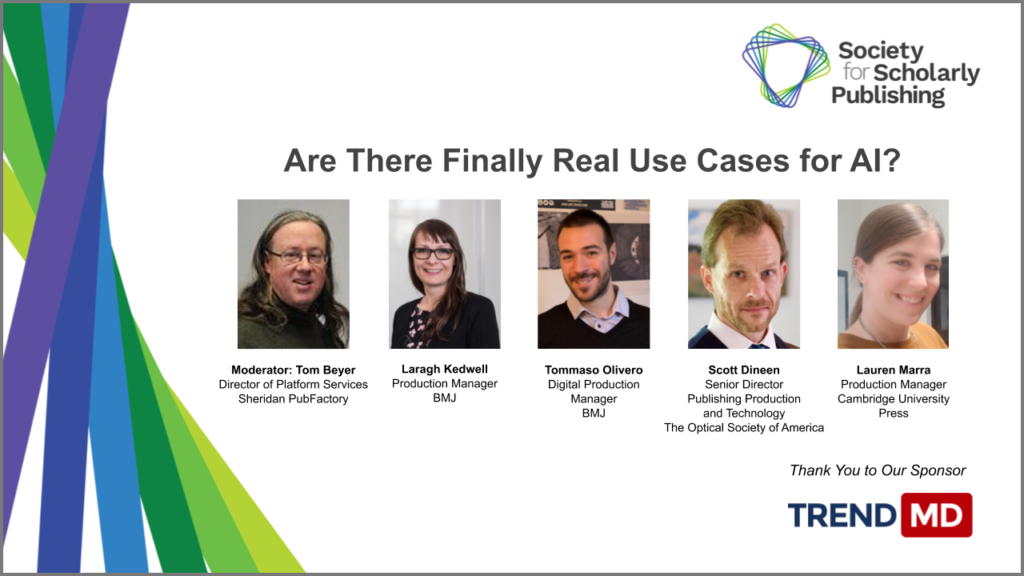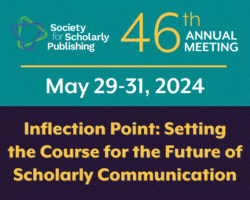
In many visionary articles, popular blogs, conference sessions, and product launches over the past few years, artificial intelligence has been pitched as the next disruptor in scholarly communications. While a number of companies have proposed new or better applications of AI technology, much of the debate thus far in our industry has been theoretical.
According to moderator Tom Beyer (Director of Platform Services, Sheridan PubFactory), this webinar’s aim is to cut past the hype and focus on real-world use cases in publishers’ workflows. Rather than dwell on the technical details of AI, the panelists explored what’s working for them in a practical sense and what publishers should know when considering similar implementations.
The first to present was Laragh Kedwell (Production Manager, BMJ), who found it difficult to maintain and identify relevant articles for new collection development and needed a fresh solution for surfacing and packaging content in new ways. BMJ enlisted Unsilo’s Classify software to extract concepts using machine learning and natural language processing, capturing semantic and syntactic relationships on an ongoing basis using the established US National Library of Medicine’s Medical Subject Headings (MeSH) taxonomy.
Tommaso Olivero (Digital Production Manager, BMJ) added that while certain things went well with the agile new system for creating new topic areas, others were less impressive. On the one hand, BMJ was better able to keep on top of everything they publish, improve customer service, automate the manual updating of collections, and explore new uses for topics identified. Meanwhile, the publisher found that the system was not able to distinguish certain concepts (different species in a veterinary journal, for example) and specialist input was still needed. He reiterated that AI is not a magic black box that will solve all problems.
Next to present was Scott Dineen (Senior Director, Publishing Production and Technology, The Optical Society). Scott described how OSA works in a multidisciplinary field with a huge range of topics; so the publisher worked with Access Innovations build its own taxonomy, the Optics and Photonics Thesaurus where none existed previously. The deep hierarchy employed machine learning technology to train the concepts over time and was tested with the help of Expert Systems to assign indexing codes, run search and browse, refer similar articles, recommend article reviewers, analyze trends, and better target marketing.
The system was adept at concept matching in search results (gold to AU, for example), and recommended articles became a popular feature. Finding reviewer candidates based on similarities in submitted manuscripts to authors of published papers and reviewer history worked very well, diversifying the reviewer pool by not relying so heavily on personal networks. OSA also used the thesaurus to normalize, standardize and shrink journal ToC categories over a two-year process.
Finally, we heard from Lauren Marra (Production Manager, Cambridge University Press) who uses Nova Techset’s Casper copyediting system to increase speed to publication and improve author service. Previously, accepted manuscripts could be turned around as author proofs in 48-72 hours but only by risking quality and author engagement. By using contextual copyediting, whereby an AI algorithm running in the background evaluates language quality and automates grammatical, stylistic and formatting refinements, overall production time has decreased by an average of 25-45% with a 33-50% reduction in turnaround times for copyediting, typesetting and correction processing. CUP has piloted Casper for five months on five STM journals, but Lauren admits that AI and machine learning only improve the more you use them. She finds that AI does not replace human intervention, but assists copyeditors who can spend more time adding value to content.
When Tom asked the panelists whether implementing these systems felt different to their organizations than prior technology initiatives, Scott responded that indeed it was a new experience, pointing out that AI allows for a great deal of consistency only possible by machine. Lauren agreed, adding that AI can be set up with levels of rules humans couldn’t match in reliability. Laragh brought up the black box problem, that manual intervention is required to fine-tune the AI, but once evaluated and tested, people come together and get excited about such a technology project.
An audience member asked whether the panelists had to fight back against perceptions that the tools wouldn’t work as well as promised, or would eliminate jobs. Scott explained that his team needed to show a minimum viable proof of concept that delivered initial results and looked real in order to move forward. Lauren said that automation doesn’t mean making someone obsolete, as the technology needs a certain level of human intervention no matter how good the quality gets—adding that it is important to be able to pivot by not putting all your eggs in one basket/vendor/tool. Tommaso described sitting down initially with the vendor and internal stakeholders to develop use cases and a roadmap to generate trust within the company.
The final question sought advice for getting started with AI. Scott suggested working within the existing organizational culture and resisting the temptation to impose ideas and assumptions. Lauren recommended always looking forward to adapt to the changing environment, not falling victim to resistance to change, which can sometimes be an issue in academia. Search engine optimization (SEO) was once a nascent practice that has now resulted in wider dissemination, she argued, and AI has similar potential. So be open to new tools, hedge your bets, and try new things.
- “Are There Finally Real Use Cases for AI?” will be available in the SSP library in late December.
News contribution by SSP member, Michael Groth. Mike is the Director of Marketing at Cenveo Publisher Services.



Join the Conversation
You must be logged in to post a comment.